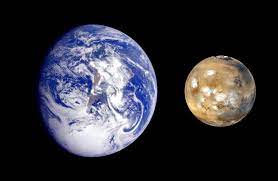Due to the similarity and proximity between Mars and the Earth, the possibility of life on Mars is a very interesting issue in astrobiology. So far, no evidence of life (past or present) has been found on Mars. In the ancient Nochian era, the surface atmosphere of Mars contained liquid water, which may be suitable for microorganisms to live in, but this habitable condition does not indicate the existence of any life forms.
Scientific research to find conclusive evidence of life began in the 19th century, and continues to this day through telescope experiments and deployment of detectors. Earlier, this work focused on theoretical phenomena and was based only on hypotheses, but modern scientific research emphasizes the discovery of chemical and biological features in water, soil, and rocks on the earth’s surface. Because Mars is similar to the early Earth, scientists have a special interest in studying the origin of life.

Mars has a cold climate with no plate tectonics or continental drift, and it has hardly changed since the end of the Hesperian period. At least two-thirds of the surface of Mars is more than 3.5 billion years old, and regardless of the existence of life, Mars may have the best record of pre-life conditions that sustain life. After confirming the previous existence of liquid water on the surface, the rover’s curiosity and perseverance in finding evidence of past life increased, including identifying autotrophic and chemical nutrient microorganisms, as well as natural water. Areas of the Martian plains associated with rivers or lakes may be habitable.
Finding evidence of habitation, penetration (related to fossils) and organic compounds on Mars is now the main goal of the National Space Administration (NASA) and the European Space Agency (ESA). The discovery of sedimentary rocks and organic compounds on Mars is very interesting because they are pioneers of pre-life chemistry. These discoveries, as well as the early breakthroughs in the discovery of liquid water on ancient Mars, further support the potential early settlement of Gale Crater on Mars. Currently, the surface of Mars is bathed in ionizing radiation, and Martin soil is rich in perchlorate, which is toxic to microorganisms. Therefore, the general consensus is that if life ever existed or still exists on Mars, it can be found underground, or it can be preserved far away from the existing rough surface.

As early as 2003, a NASA team also found some traces of methane gas in the Martian atmosphere. Methane gas can be produced by microorganisms and chemical reactions. Therefore, it is very important to determine the source of this methane gas in the Martian atmosphere. Traces of formaldehyde have also been found on Mars, which may have been produced by the oxidation of methane. Therefore, it can be said to be evidence of the existence of microorganisms in the Martian atmosphere. Economic benefits, long-term scientific research conducted by humans, human adventurous nature and curiosity are some of the main reasons for Mars colonization. The surface conditions of Mars and the presence of water make it very friendly to certain microorganisms on Earth.